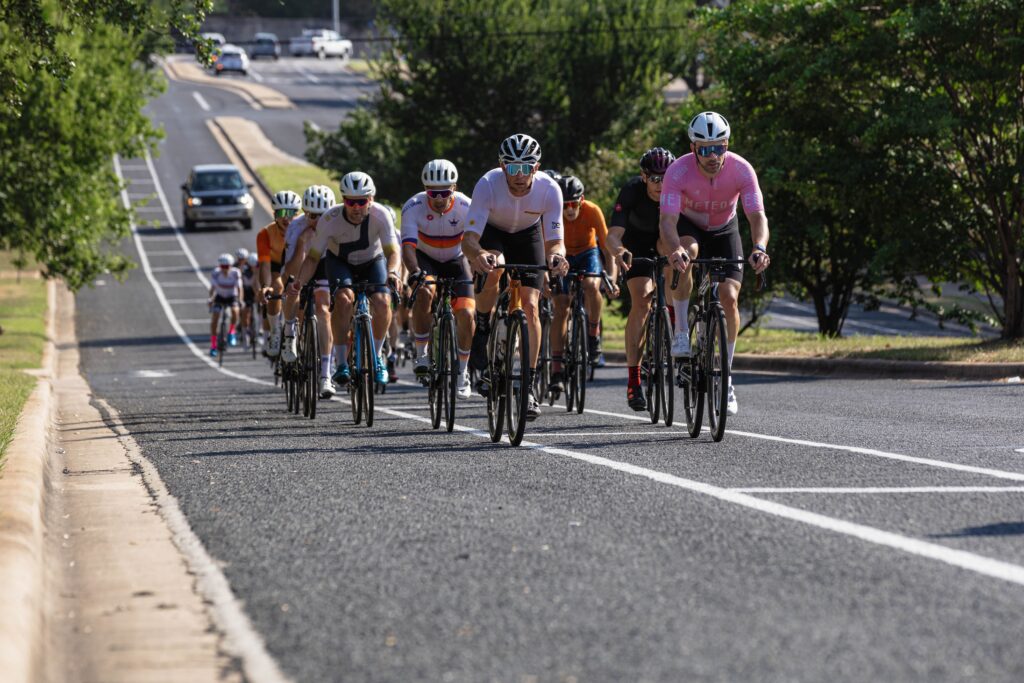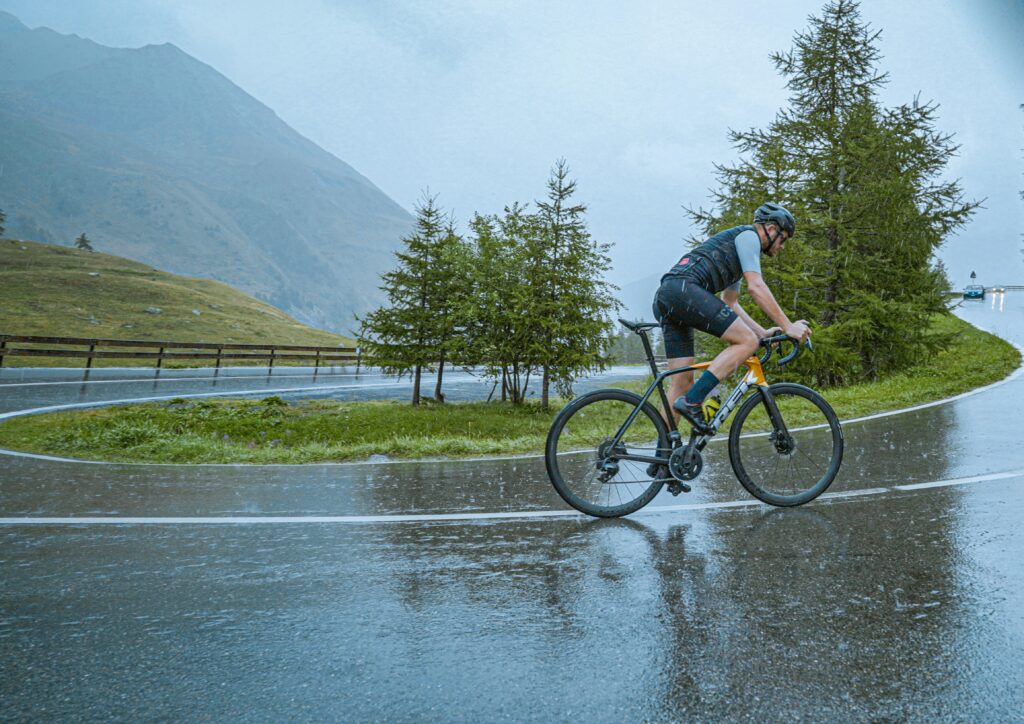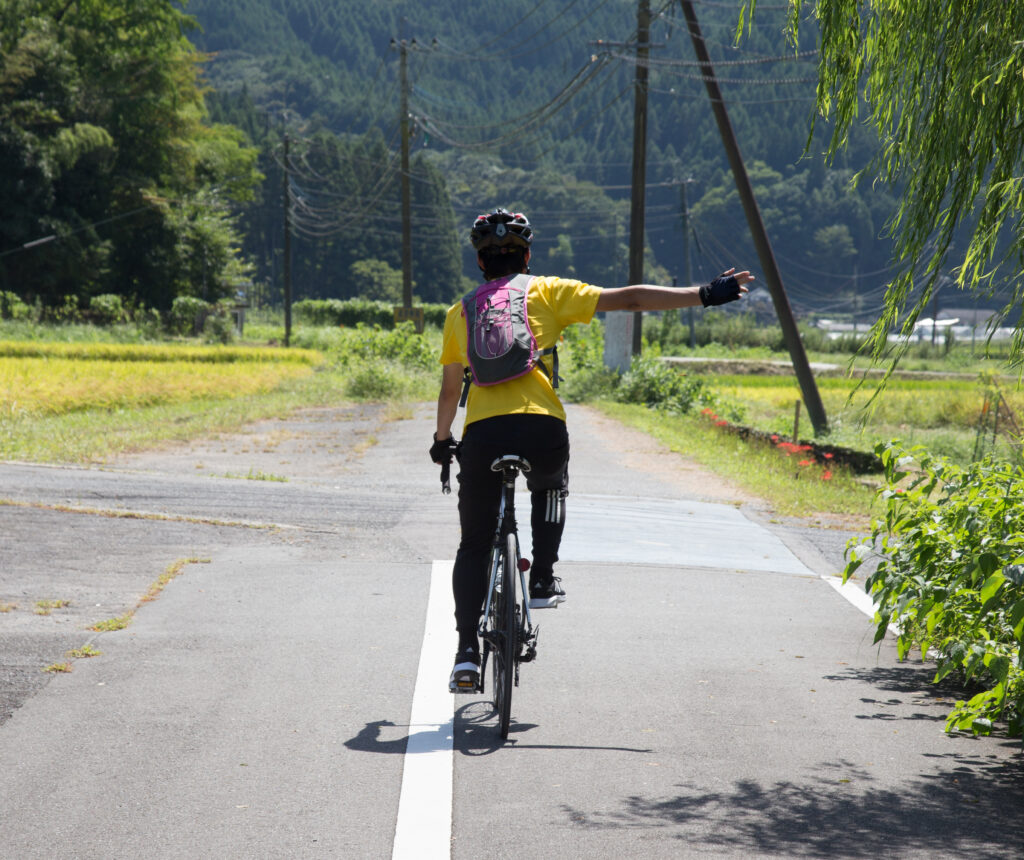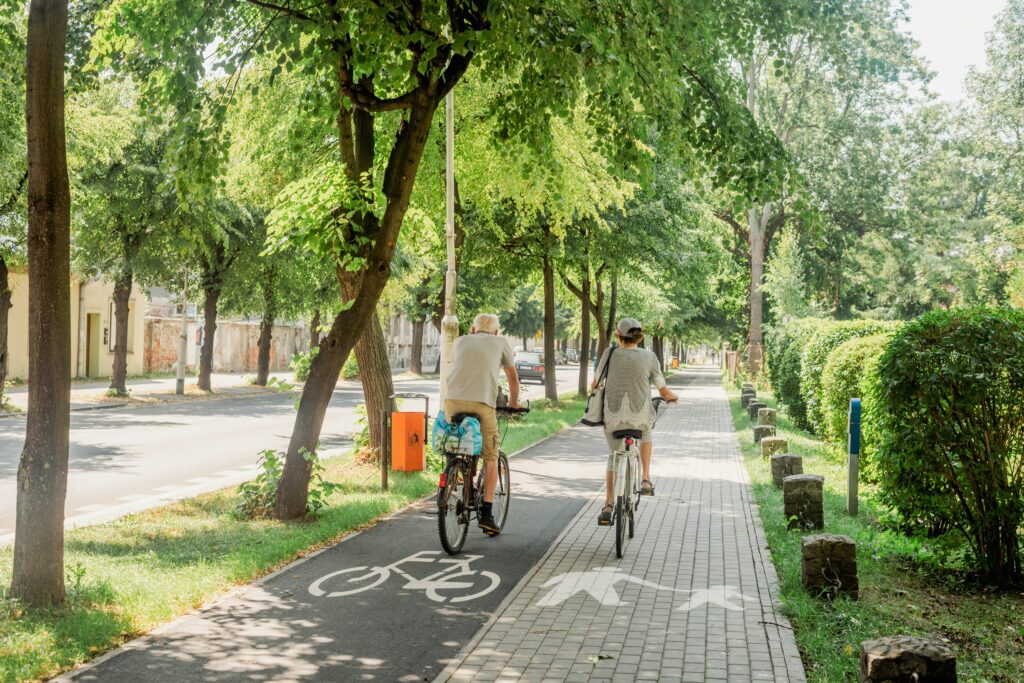Cycling Accidents in 2024: Key Trends and Safety Tips

Cycling accidents have been a growing concern, with approximately 850 reported bicyclist fatalities occurring annually in the U.S. This represents a significant increase, with bicyclist deaths rising by 42.7% since 2010. The trend has shown no signs of slowing down, highlighting the urgent need for improved bicycle safety measures, especially as bicyclist deaths occurred. Additionally, the total traffic fatalities provide a broader context, showing the overall severity of road safety issues and the need for comprehensive safety strategies.
Top 10 Rules of the Road for Cycling Safety Tips

Looking to cycle safely on the road? This article provides the 10 rules of the road for road cycling that you need to know. Follow these key guidelines to ensure a safer and enjoyable ride. Key Takeaways Wearing a helmet is essential for preventing serious head injuries and is legally required in many states. Cyclists must use hand signals to communicate their intentions and obey traffic laws to ensure safety on the road. Staying visible with bright clothing, reflective gear, and lights, as well as using dedicated bike lanes, significantly enhances road cycling safety. Always Wear a Helmet Wearing a helmet is crucial for preventing head injuries during a bike ride. Statistics show helmets can reduce serious head injuries by up to 60%, making them an essential part of your cycling gear. Imagine the peace of mind knowing your helmet could be the difference between a minor fall and a life-threatening injury. Many states require bicyclists to wear helmets by law, underscoring the responsibility to protect yourself. This legal requirement ensures every cyclist is taking necessary precautions. Not wearing a helmet can also lead to fines, adding a financial incentive to stay safer. Wearing a helmet is simply a smart decision. Accidents can happen to even the most experienced cyclists, and the head is one of the most vulnerable parts of the body. Donning a helmet is a proactive step in ensuring your safety and that of your fellow cyclists. Use Hand Signals Communication is key to road safety, and hand signals are vital. Using hand signals allows you to convey your intentions to drivers and other cyclists, reducing the risk of collisions. For instance, to indicate a left turn, extend your left arm straight out. This simple gesture alerts motorists to your movements, helping them anticipate and react during lane changes. For a right turn, you have two options: extend your right arm straight out or bend your left arm upward at a right angle. To signal that you are slowing down or stopping, extend your left arm downward with your hand open. These signals are part of the rules of the road and are crucial for avoiding misunderstandings and accidents. Obey Traffic Signs and Signals Cyclists share the same rights and responsibilities as motorists, which means adhering to all traffic laws. This includes stopping at stop signs, obeying traffic signals, and yielding the right of way when necessary. Non-compliance with traffic laws can lead to legal consequences such as fines and citations. More importantly, it significantly increases the risk of accidents. Each year, many cyclists are involved in collisions because they fail to observe these rules. Following traffic regulations helps maintain a predictable flow of traffic, enhancing safety for all road users. Riding predictably is crucial. When drivers can anticipate your actions, the likelihood of accidents decreases. This includes using hand signals, looking over your shoulder when changing lanes, and making your intentions clear to other road users. These practices keep you safer and foster a cooperative road environment. Ride in the Same Direction as Traffic Riding in the same direction as traffic is fundamental for cyclists. It reduces the risk of collisions and makes your movements more predictable to motorists. Riding against the flow of traffic confuses drivers and increases the chances of accidents. Predictability helps motorists anticipate your actions, making the road safer for everyone. This approach prevents accidents and ensures you are visible and expected on the road. Riding in the same direction is not just about safety; it’s also about legal responsibility. Cyclists must follow the same traffic laws as motorists, including riding with the flow of traffic in a straight line. This practice aligns with broader principles of road safety and legal compliance. Stay Visible with Bright Clothing and Lights Visibility is crucial for bicycle safety. Wearing bright clothing, reflective gear, and using lights can significantly improve your visibility to drivers. Bright colors and reflective materials on your clothing can catch the attention of motorists, especially in low-light conditions. At night, using lights is essential. A red rear light and a front light can make a huge difference in how well drivers see you. These lights help you see the road ahead and ensure you are seen by others. In addition to lights and bright clothing, riding in the same direction as traffic increases your visibility. Following the rules of the road makes it easier for drivers to spot you and anticipate your actions, making the road safer for everyone. Use Dedicated Bike Lanes When Available Dedicated bike lanes enhance cyclist safety by providing a separate bike lane from motor vehicles. These lanes reduce the risk of injury and improve the overall flow of traffic. Using bike lanes contributes to better traffic management by giving cyclists a clear area to ride, minimizing conflicts with motor vehicles. This separation makes it easier for both cyclists and drivers to navigate the roads safely. The presence of bike lanes can encourage more investment in cycling infrastructure, promoting a safer and more bike-friendly environment. Using these lanes, cyclists not only protect themselves but also advocate for better cycling conditions in their communities. Avoid Riding on Sidewalks Riding on sidewalks can be dangerous for both cyclists and pedestrians. Cyclists can crash into pedestrians, lose control on uneven surfaces, and surprise drivers who are not expecting them. Drivers often do not expect cyclists on sidewalks, increasing the risk of accidents when crossing streets or driveways. By avoiding sidewalks and using bike lanes instead, cyclists can ensure a safer environment for everyone. Be Cautious Around Parked Cars One common hazard for cyclists is “dooring,” where a parked car door opens unexpectedly into the cyclist’s path. To prevent such incidents, maintain a distance of at least 4 feet from parked cars. Cyclists should also slow down when approaching parked cars to increase their reaction time and account for blind spots. This extra caution helps avoid sudden accidents and ensures a smoother ride. Vigilance is key. Always watch for drivers who
Top Tips for Cycling in the Rain: Stay Safer and Enjoy the Ride

Cycling in the rain can be challenging, but with the right preparation, it can also be enjoyable. In this article, we’ll provide you with essential tips and gear recommendations to stay safe, dry, and comfortable during wet weather rides.
Mastering California Vehicles Codes for Bicycles: Group Ride Etiquette and Safety Tips

Mastering California’s bicycle laws and group ride etiquette is essential for cyclists of all skill levels. By understanding the rules of the road and the intricacies of group ride dynamics, you can ensure a safer and enjoyable cycling experience for yourself and your fellow riders. In this blog post, we’ll delve into the California Vehicles Codes for bicycles, group ride etiquette, and safety tips to help you navigate the Golden State’s roads like a pro. Short Summary Understanding California Vehicle Codes for Bicycles As a cyclist in California, it’s crucial to be aware of the state’s bicycle laws to ensure safety and adherence to traffic regulations. These laws cover various aspects, such as riding on the right side, obeying traffic signals and signs, bicycle equipment requirements, and sidewalk cycling regulations. Not only do these rules apply to solo riders, but they’re also essential during group rides to guarantee the safety of all participants. In the following sections, we’ll provide you with a comprehensive guide on these California Vehicle Codes for bicycles and how they impact group ride etiquette and safety. Keep in mind that your local bike shop can be a valuable resource for learning about these laws and acquiring essential cycling equipment. On the Right Side Riding on the right side of the road is not only a legal requirement in California, but also a crucial aspect of group ride safety and efficiency. Cyclists must ride on the right side of the road, in line with the traffic flow, except when making a legal left turn, passing other cyclists, or riding on a one-way street, road too narrow to share, or when the right side of the road is blocked off for construction or a bike lane is unavailable. During group rides, maintaining the correct position on the road is essential to avoid accidents and ensure a smooth experience for all riders. While riding on the right side, it’s important to be mindful of the group’s pace and keep an appropriate distance from other riders. Advanced group riding skills, such as riding in a pace line or double pace line, can further enhance the efficiency of the entire group and reduce the impact of wind resistance. However, there are exceptions to riding on the right side of the road in certain situations, such as passing, preparing for a left turn, avoiding hazards, or when the lane is too narrow to share. In these instances, it’s crucial to communicate your intentions clearly to the group and move to the left when it’s safer to do so. Following these guidelines will ensure a safer and more enjoyable cycling experience for everyone involved. Obeying Traffic Signals and Signs Obeying traffic signals and signs is essential for cyclists in California, as it guarantees the safety of all road users and helps prevent accidents. Cyclists must comply with all traffic signals and signs, including stop signs, yield signs, and traffic lights, just like any other vehicle on the road. During group rides, it’s particularly important to accommodate slower riders and maintain a safer and inclusive environment for everyone involved. Failing to adhere to traffic signals and signs can result in fines or other penalties, as well as create dangerous situations for both cyclists and motorists. By following the traffic laws, you’ll not only be safeguarding yourself and others, but also promoting a positive image of cyclists in your community. Bicycle Equipment Requirements In California, certain equipment requirements must be met for a safer and legal cycling experience. Cyclists are required to have a white front light and a red rear reflector or light for nighttime use. Additionally, helmets that comply with the American National Standards Institute (ANSI) or the Snell Memorial Foundation standards must be worn by riders under the age of 18. These equipment requirements are not only essential for individual cyclists, but also play a crucial role in group ride safety. The front rider should set a good example by ensuring they have the required equipment and follow the rules of the road. Properly equipped bicycles and adherence to traffic laws contribute to a safer and enjoyable group ride experience for all participants. Sidewalk Cycling Regulations While there is no state-level prohibition against sidewalk cycling in California, it’s essential to check local ordinances in your area for any additional regulations. Cycling on sidewalks can pose risks due to the presence of pedestrians, cars, and other cyclists, so it’s important to be mindful of your surroundings and adhere to the rules of the road when doing so. Experienced riders can provide valuable insights and advice on local cycling regulations and group ride etiquette, so don’t hesitate to ask for guidance from your fellow cyclists or local bike shop. By following the appropriate sidewalk cycling regulations, you’ll ensure a safer experience for yourself and those around you, especially for new riders. Group Ride Etiquette and Safety Now that we’ve covered California’s bicycle laws, let’s dive into the key aspects of group ride etiquette and safety. In the following sections, we’ll discuss communication and signaling, formation and spacing, and sharing the road with motorists. These essential elements will help you navigate most group rides like a pro and create a safer and enjoyable experience for all participants in cycling group rides. Communication and Signaling Clear communication and signaling are vital during group rides to ensure the safety of all participants. Hand signals and verbal cues, such as “car back” or “hole,” allow riders to effectively warn others of potential hazards or changes in direction. Communication is especially important when navigating through intersections or making turns, as riders need to be aware of each other’s intentions and movements. During group rides, the lead rider has a responsibility to monitor the road ahead and alert the group to any obstacles or hazards they encounter. Likewise, tail end riders play a crucial role in calling out approaching vehicles from behind and signaling lane changes when necessary. By using a combination of hand signals
Mastering Hand Signals for Road Bikes – Essential Tips for Beginner Cyclists

Did you know that mastering bike hand signals can make your cycling experience safer, more enjoyable, and even help build a sense of camaraderie among fellow cyclists? In this blog post, we will delve into the world of hand signals for road bikes, exploring their importance, the basic and advanced signals every cyclist should know, and some tips for effective signaling. Let’s get started on this journey to safer and more confident cycling! Key Takeaways The Importance of Hand Signals for Road Bikes Hand signals hold significant importance in the cycling universe due to several reasons. Unlike motor vehicles, bikes don’t come equipped with built-in signals to communicate their intentions to other road users. The absence of built-in signals necessitates learning and utilizing bike hand signals for cyclists at all experience levels, making bike hand signals important. Hand signals not only augment safety, but also are instrumental in fostering better communication between cyclists and other road users including motorists, pedestrians, and peers. Enhancing Safety Hand signals play a key role in ensuring cyclists’ safety by notifying other riders and road users of their plans and movements. For instance, to signal a left turn, extending your left arm straight out to the side is a common and easily recognizable hand signal used by cyclists. Indicating your intention to stop ahead of time is also crucial in averting potential collisions with cars or other cyclists, as bikes don’t have brake lights like motor vehicles. In cases of sudden or sharp stops, the call of “Stopping!” may be essential when there is insufficient time to make the signal. Improving Communication Clear communication between cyclists and other road users is vital to minimize the chances of accidents. Hand signals facilitate this communication, bridging the gap between cyclists and motor vehicles, which have built-in signals for their intentions. Utilizing hand signals to acknowledge other road users also encourages positive interactions and fosters harmonious road-user relations. As you can see, hand signals play a vital role in both enhancing safety and improving communication among all road users. Basic Hand Signals Every Cyclist Should Know Having underscored the significance of hand signals, let’s explore some basic bike hand signals that every cyclist should know. These include: Mastering these basic hand signals not only ensures your safety on the road, but also aids in effective communication with other road users, ensuring a smoother and more enjoyable riding experience. Slowing Down and Stopping To signal that you’re slowing down on a road bike, you can use the following hand signals: It’s recommended to use the hand signal before reaching a junction or a stop sign. In group rides, verbally announcing “Stopping” can be beneficial, as it allows riders to free up both hands for braking. Turning Left and Right Hand signals for left and right turns are key to conveying your planned direction to other road users. Extend your left arm horizontally to the side to signal a left turn. For a right turn, extend your right arm horizontally to the side. It is recommended to signal approximately 100 feet prior to the turn. Properly using these hand signals will help ensure that other road users are aware of your intentions, reducing the likelihood of accidents. Hazard Warnings Hazard warning hand signals function to alert cyclists of potential dangers on the road, such as potholes, debris, or obstacles. To indicate a hazard, extend your arm out in the direction of the hazard and wave your arm up and down in a repetitive motion. In case of an oncoming hazard, extend your arm out to the side of the hazard behind you and indicate across your back the direction in which the cyclist behind you will need to move to avoid it. Utilizing these hazard warning hand signals can greatly enhance the safety of all cyclists on the road. Advanced Hand Signals for Group Rides In addition to the basic hand signals, there are also advanced hand signals specifically tailored for group rides. These include taking turns at the front, navigating obstacles, and acknowledging other road users. Gaining proficiency in these advanced hand signals can notably enhance your group riding experience and help maintain a sense of camaraderie among fellow cyclists. Taking Turns at the Front Cyclists can employ hand signals to suggest when others should take the lead in the group. The elbow flick hand signal is utilized to signify that a rider is finished “pulling” and intends to move off to the side and take up a position at the back of the group. The “Come Through” hand signal involves extending one’s elbow outward to indicate the desired direction for the wheelsucker(s) to pass. Using these hand signals can help maintain a smooth and efficient group ride, ensuring everyone shares the workload. Navigating Obstacles The use of specific hand signals can simplify navigating obstacles in a group ride by guiding fellow cyclists. To indicate navigating around an obstruction in the road, signal the direction of movement behind the back with the arm on the side of the obstruction. Additional hand signals commonly used for navigating obstacles when riding in a group include signaling to decelerate, signaling to turn left or right, and signaling to alert of a potential hazard. Employing these hand signals when maneuvering obstacles in a group ride aids in directing other cyclists and guarantees the safety of all participants. Acknowledging and Thanking Other Road Users The use of hand signals to acknowledge and thank other road users fosters positive interactions and bolsters relations among road users. A thumbs up hand signal is a sign of gratitude, typically used when a rider moves over to provide more space or when another road user is courteous enough to wait for the group to pass. Utilizing hand signals to acknowledge other road users not only fosters a sense of camaraderie among cyclists, but also helps create a safer and more respectful environment on the road. Common Calls Used in Conjunction with Hand Signals Besides hand signals,
How to Navigate Biking on Sidewalk: Rules and Tips

Wondering if BIKING ON SIDEWALK is allowed and safer? Many cyclists prefer sidewalks to busy streets, but this choice comes with specific rules and risks. This article explores the legal aspects, safety measures, and best practices for riding on sidewalks, including the nuances of BIKING ON SIDEWALK. KEY TAKEAWAYS Sidewalk cycling poses unique safety risks, including reduced visibility and potential conflicts with pedestrians, making it crucial for cyclists to assess local regulations and traffic conditions before riding. Local laws regarding sidewalk cycling vary significantly; cyclists must be well-informed about specific regulations in their area to avoid legal issues and ensure safer biking practices. Cyclists are advised to yield to pedestrians, use audible signals when passing, and prefer bike lanes when available to enhance safety and comply with local traffic laws. Understanding Biking on the Sidewalk Sidewalk cycling, the act of riding a bicycle on designated pedestrian walkways, is a practice that often stirs debate. While sidewalks are primarily designed for pedestrian use, many cyclists find themselves using these paths for various reasons—be it safety concerns on busy roads or a lack of dedicated bike lanes. However, this practice brings its own set of challenges and risks. Cyclists on sidewalks face unique safety hazards, including reduced visibility at intersections and driveways, and potential conflicts with pedestrians. In fact, many areas expect adults to ride on the street rather than on sidewalks to mitigate these risks. For instance, New York City generally discourages sidewalk cycling due to high pedestrian traffic. Understanding these nuances is the first step in ensuring safer and legal rides. Safety Considerations for Sidewalk Cycling Photo by Eugenia Pankiv on Unsplash Safety is paramount when it comes to sidewalk riding. Cyclists must navigate a host of potential hazards, from unexpected encounters with pedestrians to visibility issues at intersections. It’s essential to assess whether sidewalk cycling is the safest option based on local regulations and the density of pedestrian traffic. Let’s delve into some specific safety considerations. Visibility Issues Reduced visibility is a significant concern for cyclists on sidewalks. When riding on sidewalks, cyclists often find themselves less visible to vehicles, particularly at intersections and driveways. This decreased visibility increases the risk of accidents, as drivers may not expect a cyclist to be crossing their path. Cyclists need to exercise extra caution and make sure they are visible to oncoming traffic. Driveway and Intersection Risks Cyclists face significant risks at driveways and intersections. Vehicles exiting driveways or nearing intersections might not expect bike traffic, increasing the chance of accidents. Cyclists should slow down, remain vigilant, and be ready for sudden vehicle movements. Crossing from a sidewalk to the road requires awareness of oncoming traffic and a cautious approach. Pedestrians Conflicts with pedestrians are another critical issue in sidewalk riding. Crowded sidewalks, obstacles, and limited space can lead to accidents. Cyclists should consider dismounting and walking their bikes at busy intersections to avoid collisions. Minimizing conflicts and ensuring safety on shared pathways involves respecting pedestrian space and exercising patience. Obeying Local Laws Local laws regarding sidewalk cycling can vary significantly, making it vital for cyclists to be well-informed. Different states and municipalities have their own regulations, and what is permitted in one place may be prohibited in another. Knowing these local laws helps avoid legal issues and promotes safer cycling practices in accordance with local ordinance. Always remember to check local laws. State and local regulations can differ widely when it comes to sidewalk cycling. California, for example, lacks a uniform state law for bicycle use, so local jurisdictions set specific rules. In contrast, New York City generally restricts sidewalk cycling to children under 13 and certain small-wheeled bicycles. Pennsylvania allows sidewalk cycling unless local regulations state otherwise. Knowing these distinctions is crucial for legal compliance. Due to the variability in local laws, cyclists should verify regulations in their specific area. For example, New York City prohibits riding on sidewalks unless explicitly allowed by signage. New Jersey does not ban sidewalk cycling at the state level, but some municipalities have local prohibitions. Additionally, several states require cyclists to give an audible warning before overtaking pedestrians. Examples of varying local laws underscore the need to stay informed. In New Jersey, some local governments ban sidewalk cycling despite state permissions, whereas New York City permits it only in certain areas. Resources like the Bike League provide comprehensive overviews of bike law, bicycle laws, and state laws across states, aiding cyclists in navigating these complexities. Major states have their own specific rules regarding sidewalk cycling, reflecting diverse approaches to regulation and sidewalk cycling vary, along with separate laws. Consider the specific rules in California, New York, and Florida. California In California, the absence of a statewide law on sidewalk cycling means local ordinances are crucial. Regulations can vary significantly between cities and counties, with some areas allowing sidewalk cycling only on designated bike routes. Cyclists must be aware of local rules to prohibit riding and ensure compliance. New York New York’s regulations are stringent, particularly in New York City, where sidewalk cycling is generally illegal except under specific circumstances. Cyclists must adhere to traffic laws, including obeying signals and signs, and ride with traffic. Motorists must treat cyclists with the same rights and responsibilities as other motor vehicle, promoting mutual safety. Safety gear requirements, such as functional brakes and lights, are also enforced. Florida In Florida, cyclists are generally allowed to ride on sidewalks unless local ordinances prohibit it. However, cyclists must yield to pedestrians and follow additional local regulations for safer riding. Business Districts and Restricted Areas Business districts and high-traffic areas often have specific restrictions on sidewalk cycling. Local ordinances typically dictate whether cyclists can ride on sidewalks in these areas. For example, Pennsylvania allows sidewalk riding unless local laws prohibit it, which is common in populated areas. States like Hawaii and Missouri restrict sidewalk cycling in business districts, expecting cyclists to use the road instead. Cyclists have specific rights and duties when riding on sidewalks. They must yield to


